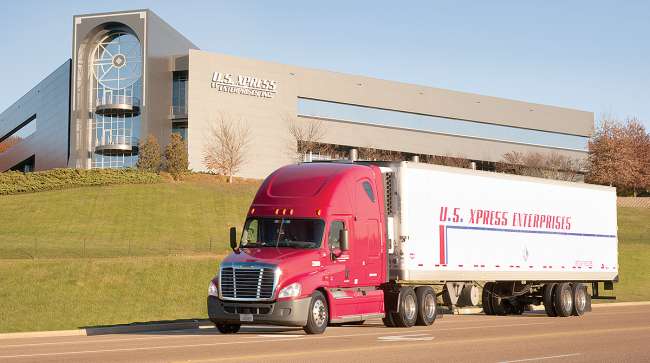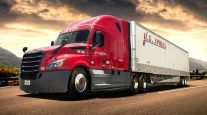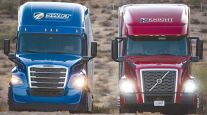U.S. Xpress Enterprises' Efficiency Moves Pay Off

Efforts by dry van truckload carrier U.S. Xpress Enterprises to boost profits by improving the efficiency of its trucking operations are paying off.
The Chattanooga, Tenn.-based company reported net income of $7 million, or 14 cents a share, in the fourth quarter of 2018. While that compares with $9.5 million, or $1.49 a share, in the same period a year ago, results in the fourth quarter of 2017 included $12.4 million in tax benefits related to the Tax Cuts and Jobs Act of 2017.
Revenue climbed 8.8% to $469.2 million from $431.2 million.

CEO Eric Fuller. (U.S. Xpress Enterprises)
Operating income in the fourth quarter was $21.1 million, an increase of 69% compared with $12.5 million in 2017.
More importantly, the company’s adjusted operating ratio of 92.5 improved for the sixth consecutive quarter and was the best in 20 years, according to CEO Eric Fuller.
The operating ratio is a key measure of profitability for trucking companies and is calculated by dividing operating expenses by total revenue.
“Our focus has been to manage the business by core metrics that impact rate, truck count, utilization and cost and measure our success by our adjusted operating ratio,” Fuller said in a Feb. 8 statement. “With record financial results, positive early year momentum and an improved capital structure from our June initial public offering, we are well-positioned to continue methodically managing our capital allocation, improving our operational execution and targeting industry-leading profitability.”
In January, U.S. Xpress announced plans to sell off its U.S.-Mexico cross-border trucking operations, including its terminal in Laredo, Texas, and a fleet of more than 700 trailers.
Fuller said the move will allow the company to shift more capacity to more profitable domestic traffic lanes and reduce capital expenditures needed to maintain the Mexican fleet.
Fuller said the adoption of a variable cost business model for cross-border shipping will generate more than $10 million annually in profits beginning in the fourth quarter of 2019.
Looking at truckload operations in the United States, Fuller noted that market conditions have allowed rate increases of about 7% on about 20% of the contracts for 2019 and that he expects full-year contract rates to increase between 5% and 8%.
Average revenue per tractor per week was $3,897 in the fourth quarter of 2018, compared with $3,741 in the same period a year ago. The average number of tractors overall was down slightly, with over-the-road tractors falling to 3,525 from 3,717 and dedicated tractors increasing to 2,770 from 2,583.
Brokerage revenue was $64.9 million in the fourth quarter of 2018, up 16.2% from $55.8 million in 2017, but the gross margin shrank to 13.9% from 15%, the company reported.
For the year, U.S. Xpress reported net income of $24.9 million, or 83 cents a share, in 2018 compared with a net loss of $4.1 million, or 64 cents a share, in 2017. Revenue was $1.8 billion compared with $1.56 billion.
The goal for 2019, Fuller noted, is to continue the quest for greater profitability while keeping the fleet size steady and using new tractor technology and other initiatives to increase revenue and lower costs.
One of the initiatives is a program to develop and train truck drivers with a new professional driver development center slated to open Feb. 19 in Tunnel Hill, Ga. The facility features a driving simulator, dedicated driving range and a technology lounge for teaching individuals how to use electronic logging devices.
“We continue to expect to achieve four quarters of year-over-year adjusted operating ratio improvement with a targeted full-year adjusted operating ratio of 93,” Fuller said.
U.S. Xpress ranks No. 21 on the Transport Topics Top 100 list of largest for-hire carriers in North America.




